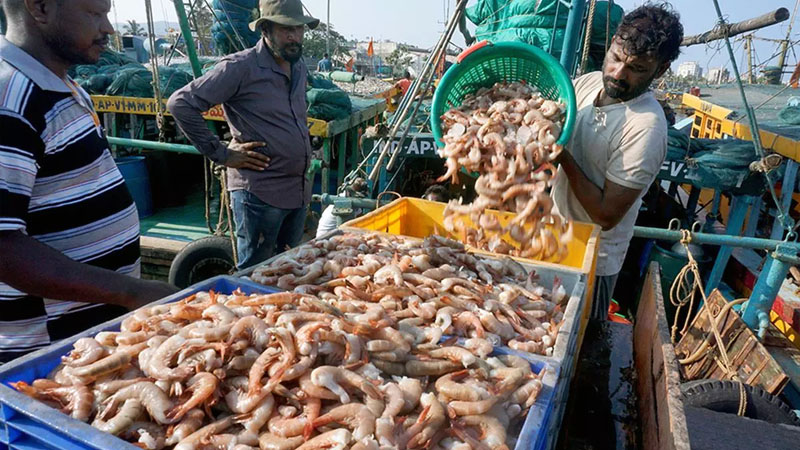Exclusive content

India’s seafood industry has urged its government to dismantle a 30% duty on shrimp imports from the United States. This call, emerging from a sector that blends economic ambition with domestic sensitivities, arrives amid evolving market currents and a fraught bilateral trade relationship.
The Tariff Tangle
The duty, a longstanding fixture of India’s trade policy, aims to shield its domestic shrimp farmers from the competitive tide of foreign imports. Yet, the seafood industry—encompassing processors, exporters, and traders—contends that this protectionist measure is backfiring. Far from safeguarding their interests, it inflates costs for businesses reliant on high-quality American shrimp, prized for their size and flavor, particularly from the Gulf of Mexico. These imports, though modest in volume, are vital for processors catering to premium international markets.
India’s shrimp industry is no small fry. In 2023, its exports reached $5 billion, according to the Marine Products Export Development Authority, with the United States absorbing roughly 30% of that haul. By contrast, US shrimp exports to India totaled a mere $50 million last year, per estimates from the US Department of Commerce. The 30% duty, however, drives up the price of these imports, squeezing margins for Indian firms that reprocess or re-export them. The industry argues that scrapping the tariff would enhance competitiveness, lower costs, and ultimately benefit consumers.
A Domestic Divide
This proposal has not landed without ripples. India’s shrimp farmers, concentrated in coastal powerhouses like Andhra Pradesh and Tamil Nadu, view the duty as a bulwark against cheaper American imports that could flood the market and depress local prices. Aquaculture is a linchpin of these regional economies, employing thousands and wielding considerable political influence. Any move to liberalize trade risks igniting a backlash from this vocal constituency, pitting producers against processors in a classic economic standoff.
The Global Shrimp Game
The stakes extend beyond India’s shores. Shrimp is a heavyweight in the global seafood trade, with the US importing over 1.5 billion pounds in 2020, valued at $6 billion, according to the National Marine Fisheries Service. India ranks among the top suppliers, alongside Indonesia and Ecuador, while its own imports from the US pale in comparison. Yet, the duty’s impact reverberates through supply chains, affecting the availability of premium shrimp varieties that Indian processors covet for high-value markets.
Broader market shifts add urgency to the debate. Disease outbreaks, such as white spot syndrome in Asian shrimp farms, and sustainability pressures have disrupted global production. The US, though a minor exporter, offers a stable, high-quality supply—attributes that India’s industry seeks to leverage. Meanwhile, evolving consumer tastes and the rise of alternative proteins loom as long-term challenges for the sector.
Trade Tensions and Opportunities
This shrimp skirmish unfolds against a backdrop of testy US-India trade relations. The Trump administration’s 2019 decision to strip India of its Generalized System of Preferences (GSP) status—a program granting duty-free access for certain exports—sparked retaliatory tariffs from New Delhi, including on American agricultural goods. The Biden administration has since signaled a desire to reset ties, but progress remains halting, bogged down by disputes over steel tariffs, digital taxes, and farm subsidies.
The shrimp duty could prove a manageable starting point for negotiators. Its removal might coax reciprocal concessions from the US—perhaps easing restrictions on Indian mangoes or pharmaceuticals—without upending broader trade dynamics. Recent data from the US International Trade Commission shows bilateral trade reached $191 billion in 2022, yet irritants like the shrimp tariff highlight persistent friction. A small gesture here could signal goodwill in a relationship hungry for momentum.
Weighing the Odds
The Indian government faces a delicate calculus. On one hand, liberalizing shrimp imports aligns with a globalized vision of trade, potentially strengthening an export-driven industry that employs millions. On the other, it risks alienating a rural base at a time when political stability is prized. The Seafood Exporters Association of India has long advocated for freer trade, arguing that access to diverse inputs fuels growth—a view echoed in a 2023 report by the Indian Council for Research on International Economic Relations, which noted that tariff reductions could boost seafood exports by 5-7% annually.
Yet, the political arithmetic may tilt the scales. With elections looming in key shrimp-farming states, the government may opt to preserve the status quo rather than court controversy. The global push against protectionism, amplified by post-pandemic supply chain woes, adds pressure, but domestic realities often trump international optics.